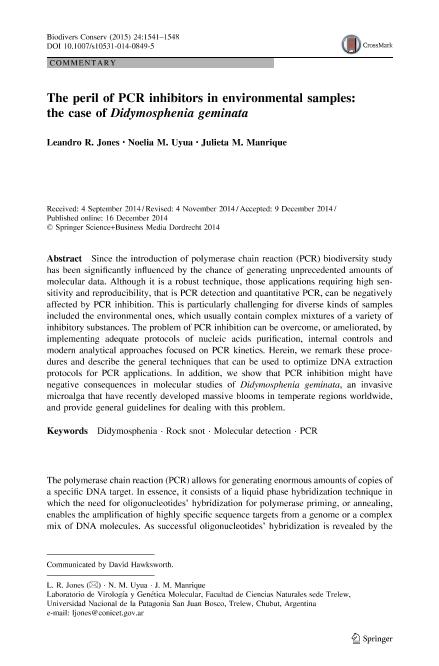Artículo
The peril of PCR inhibitors in environmental samples: the case of Didymosphenia geminata
Fecha de publicación:
06/2015
Editorial:
Springer
Revista:
Biodiversity and Conservation
ISSN:
0960-3115
e-ISSN:
1572-9710
Idioma:
Inglés
Tipo de recurso:
Artículo publicado
Clasificación temática:
Resumen
Since the introduction of polymerase chain reaction (PCR) biodiversity study has been significantly influenced by the chance of generating unprecedented amounts of molecular data. Although it is a robust technique, those applications requiring high sensitivity and reproducibility, that is PCR detection and quantitative PCR, can be negatively affected by PCR inhibition. This is particularly challenging for diverse kinds of samples included the environmental ones, which usually contain complex mixtures of a variety of inhibitory substances. The problem of PCR inhibition can be overcome, or ameliorated, by implementing adequate protocols of nucleic acids purification, internal controls and modern analytical approaches focused on PCR kinetics. Herein, we remark these procedures and describe the general techniques that can be used to optimize DNA extraction protocols for PCR applications. In addition, we show that PCR inhibition might have negative consequences in molecular studies of Didymosphenia geminata, an invasive microalga that have recently developed massive blooms in temperate regions worldwide, and provide general guidelines for dealing with this problem.
Palabras clave:
Didymosphenia
,
Molecular Detection
,
Pcr
,
Rock Snot
Archivos asociados
Licencia
Identificadores
Colecciones
Articulos(SEDE CENTRAL)
Articulos de SEDE CENTRAL
Articulos de SEDE CENTRAL
Citación
Jones, Leandro Roberto; Uyua, Noelia Mariel; Manrique, Julieta Marina; The peril of PCR inhibitors in environmental samples: the case of Didymosphenia geminata; Springer; Biodiversity and Conservation; 24; 6; 6-2015; 1541-1548
Compartir
Altmétricas




